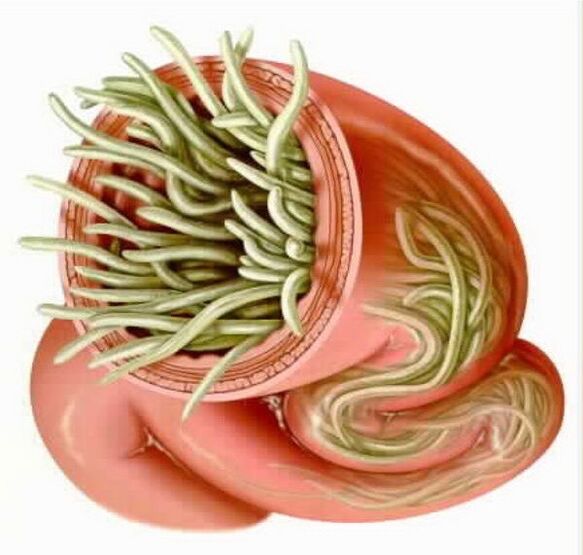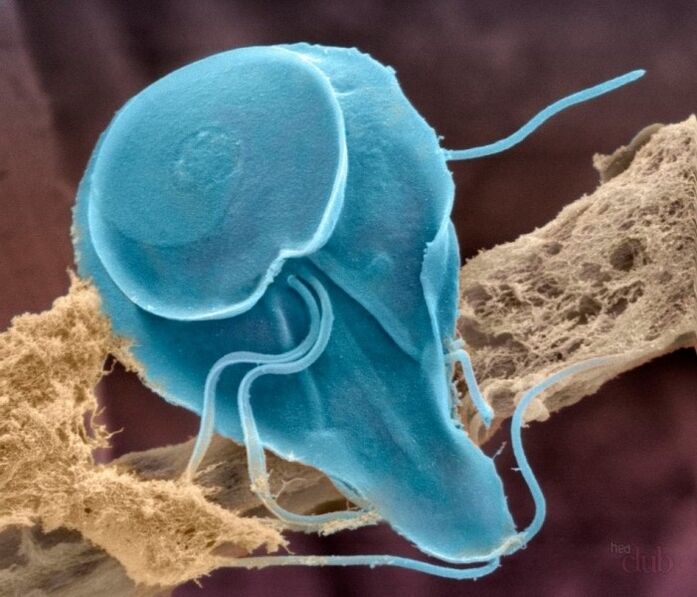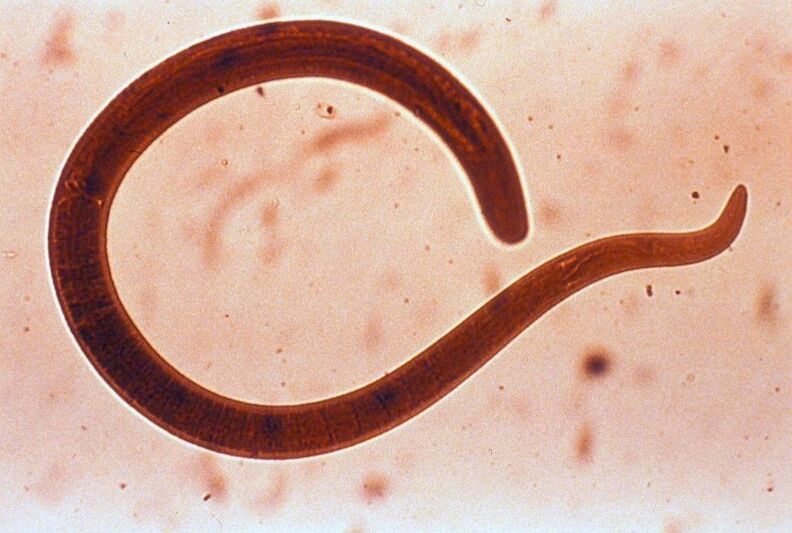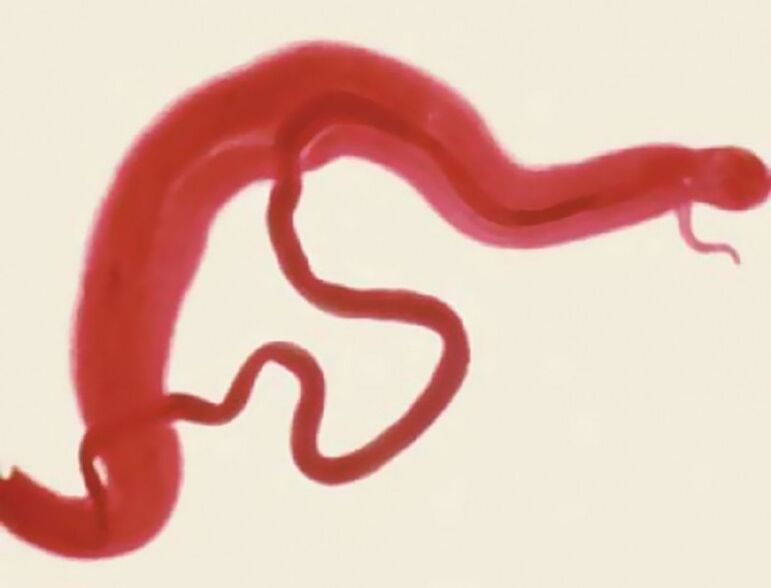Parasites in the human bodyappear quite suddenly. The reason for this is usually direct contact with the source of the infection, for example, with an infected person or object. There are many types of parasites that can be placed in the human body: they can be lamblia, pinworms, alveococci, trichinella, schistosomes, etc.
Parasites in the human body

The human body has a very complex structure, which is susceptible to various diseases and infections, infections, viruses and parasites. Parasites that settle in the human body are microorganisms that lead a parasitic lifestyle, trying to survive by feeding on other organisms, microorganisms, cells, etc.
Parasites that live in the human body are microorganisms that lead a parasitic lifestyle, trying to survive by feeding on other organisms, microorganisms, cells, etc.
Parasites that find fertile ground for life and reproduction in the human body, cause very serious damage, sometimes irreparable to his health, destroy the body from within, eat it and sometimes lead to the death of a person, or stop workof individual organs, which also worsens a person's quality life, depresses and, ultimately, shortens his life.
There are millions of species of parasitic worms in the wild. Of these, there are those who parasitize only one representative of the animal world. But in nature there are also species that can exist in the body of some species of animals. What parasites live in the human body is a question many people ask.
A large variety of helminth species can live in the human body. Some of them are very rare, while others very often settle inside and can lead a parasitic lifestyle for up to several decades.
Varieties of parasitism
There are the following types of parasitism: ectoparasitism - parasites that lead a superficial lifestyle in the human body. This category includes lice, bugs, ticks; endoparasitism - parasites that affect a person's internal organs. They, in turn, are divided into two major groups of protozoa and helminths.
Types of parasitic protozoa: lamblia, toxoplasma, trichoinada. These types of protozoan parasites are most often found in the human body.
Classification of helminth-related parasites implies their division into three major groups: nematodes; trematode; cestodet.
Types of parasites in the human body
Stake worms
Stingworms are the most well-known intestinal parasites. The disease caused by sting worms is called enterobiasis. Not only humans suffer from it, but also great apes. Children are at increased risk of worm infection. According to various sources, the level of their involvement in enterobiasis in preschool age varies from 25 to 90%. Stake worms pass from one person to another. Infection occurs through a handshake, clothing and any items touched by a sick person, provided that after contact the hands are not washed and the worm eggs are put in the mouth (this happens especially often during a meal).Flies and cockroaches can lay the eggs of these nematode worms by planting their food. Needle worms live in the small intestine, in the large intestine, in the large intestine. They join in the ileum, after which the female crawls out of the anus through the rectum and lays eggs in the anus.
Symptoms of enterobiasis include itching in the anal area, intoxication of the body (allergic reactions, exhaustion, fatigue), anemia, an increase in the level of eosinophils in the blood, insomnia and abdominal pain.Anthelmintic drugs are used to get rid of enterobiasis. The dosage and course of treatment is chosen by the doctor. To avoid re-infection, it is important to keep your hands clean, wash them after visiting a public place, after using the toilet, before eating, etc.
Nails should be cut short, bedding and footwear should be thoroughly disinfected and the apartment cleaned daily.
Toksokara
Toxocariasis can be suspected by enlarged lymph nodes: the visceral form of toxocariasis is the most common, occurring with damage to internal organs (intestines, respiratory system, heart valves).
A person may experience abdominal pain, right hypochondrium, dyspeptic disorders, nausea; if the respiratory system is damaged, a person has shortness of breath, dry cough, choking attacks; if toxocytes are placed in the heart valves, then the patient has weakness, blue fingers and nasolabial triangle, shortness of breath; the shape of the skin is characterized by itching, a feeling of movement under the skin, inflammation of the skin and mucous membranes; in neurological form, the parasite provokes the development of inflammation of the meninges and the brain tissue itself.
It manifests itself in headaches, nausea and vomiting, seizures and other neurological disorders. For the treatment of toxocariasis, anthelmintic drugs are used, as well as pathogenetic and symptomatic therapy.
Human Ascaris
Human Ascaris is a roundworm that parasitizes the small intestine. The disease that these parasites provoke is called ascariasis. The owner of the worms and the source of the infection is a sick person. Along with its feces, worm eggs enter the soil, where they mature to larvae. This soil is then transferred to food or human hands, and if the rules of personal hygiene are not followed and if fruits, vegetables and berries are poorly processed, it is transferred to the digestive tract.
Children and rural residents are more susceptible to infection. Ascariasis manifests itself at different stages of its development in different ways. In the stage of larval migration through the body, an increase in body temperature occurs, a dry cough appears, wheezing in the lungs and lymph nodes increase in size. Children suffer from ascariasis more severely than adults.
Allergic skin reactions are a characteristic symptom of ascariasis. During intestinal parasitism, the patient develops dyspeptic disorders, loose stools are replaced by constipation, frequent abdominal pain, nausea and vomiting appear. On the part of the nervous system, hysterical crises, insomnia, mental fatigue and headaches are observed.
For the treatment of ascariasis in the larval migration phase, patients are prescribed some anthelmintic drugs while parasitizing intestinal worms, others.
Circles and nectar
Flies and nectar are two types of roundworms that belong to the family Ancylostomatidae and cause a disease called wild worm. There are two ways of infecting the human body with these parasites - fecal-oral (drinking contaminated water, fruits, vegetables) and percutaneous in contact with the soil (penetration occurs through the skin).
Clinical symptoms of ankylosing spondylitis: papular vesicular rash, shortness of breath and cough, loss of appetite, nausea, abdominal pain, loose stools, iron deficiency anemia. Treatment is reduced to taking anthelmintic drugs and eliminating anemia with iron supplements.
Wide bar
Wide strip refers to worms of the order Pseudophyilidea. These parasites live in the small intestine of humans and those mammals that consume fish. Infection with a tapeworm provokes the development of a disease such as difilobotriasis.
There are 12 types of worms that can parasitize the human body, however, the wider worm is the most common. Infection occurs when you eat raw and thermally raw fish with light salt or caviar, which contains worm eggs. Symptoms of the presence of the parasite in the intestines: nausea, abdominal pain, anemia.
In severe cases, intestinal obstruction develops. To get rid of the parasite, patients are prescribed antiparasitic drugs. Upon completion of the therapeutic course, a second study is mandatory for the presence of a worm in the body. If necessary, the use of anthelmintic drugs is repeated.
Bull Tape
Taurus tape is a tape that belongs to the tenidi family. In the larval stage, it affects cattle and in the tapeworm stage it lives in the human body (in its intestines). The tape provokes a disease called teniarinhosis, as a rule, a parasite is present in the patient's body. Human infection occurs through the food route after eating heat-treated meat (beef).
Clinically, the disease is manifested by nausea, excessive appetite, abdominal pain, unstable stools and allergic reactions of the urticaria type. An anthelmintic agent is prescribed to remove the bovine tapeworm from the body. In parallel, the patient should adhere to a slag-free diet, apply cleansing enemas, take laxatives. After using an anthelmintic agent, the worm dies and leaves the human body naturally. Sometimes its length can be up to 12 meters.
Pork ribbonPork tapeworm is a parasitic worm that infects mammals. Intermediate carriers can be pigs, dogs, rabbits, camels, but the ultimate owner is always a man.
If an adult parasite is found in a person's body, then they are talking about a disease such as teniasis. When the parasite is in the patient's body in the larval stage, the disease is called "cysticercosis".
Infection of pork strips occurs when eating raw pork. Sometimes the sources of cisticercini are hand planting or watering. A patient with teniasis poses an epidemiological risk both to himself (infection by larvae of the brain, skin, eyes, or skeletal muscle) and to others.
Symptoms of tenesmus: abdominal pain, loss of appetite, bowel movements, headache, frequent dizziness, fainting (tenesmus of the brain and eyes is extremely dangerous). For the treatment of teniasis, the patient is placed in a hospital. Under the supervision of doctors, he was prescribed anthelmintic drugs, after which, after 2 hours, the patient receives a saline laxative, which allows him to get rid of the worm segments and eggs. For the treatment of cysticercosis of the eyes and brain, surgical intervention is necessary.Ekinokoku
Infection is transmitted through contact (in the process of cutting corpses, when interacting with a sick animal), or food (when eating contaminated food or water). At risk are people who deal with livestock or who have constant contact with animals. Symptoms may not appear for many years.
When the asymptomatic phase is over, pain, itchy skin and urticaria appear at the larval invasion site. In addition, the functioning of the organ within which the echinococcus larva parasitizes suffers. An increase in body temperature and fever is observed during cyst suppuration.
A complete cure for echinococcosis is only possible with surgery. The cyst is cortical, taking care not to damage its membrane. If the bladder is too large, then it is punctured and the contents inhaled. Before and after surgery, the patient is prescribed antiparasitic drugs. In the case of radical removal of the cyst, the prognosis for healing is favorable.
Alveokoku
Alveococcus is a helminth from the group of cestodes. The worm exclaims a life-threatening disease of alveococcosis, which is characterized by the formation of a primary focus in the liver with the subsequent spread of metastases to other organs. Infection occurs when parasite oncospheres enter the mouth.This can happen during hunting, in the process of cutting wildlife carcasses, in contact with pets or when eating raw berries and herbs from the forest. Symptoms of alveococcosis are reduced to pain in the right hypochondrium, stuttering, nausea. There is often itching, allergic reactions. Exclusion of a tumor with a parasite and its progression to the abdominal or pleural cavity are not excluded.
Alveococcal metastases can be found in the brain and lungs. Treatment of the disease is quick, but should be supplemented with taking antiparasitic drugs.

Giardia
Giardia (another name for Giardia) are flagellate parasites belonging to the Diplomonadid order. Giardia provokes a disease called "giardiasis" and parasitizes in the small intestine of humans, as well as many other mammals and even birds.
Giardia infection occurs through the fecal-oral route: food, water and home contact methods. Of greater importance in terms of transmission of infection is the use of raw water, contaminated food, the use of public items planted with lamblia cysts. The main symptoms of giardiasis are nausea, painful sensations in the abdomen, bowel movements and excessive gas.
Furthermore, patients suffer from allergic reactions, intoxication and neurotic disorders. The therapy of giardiasis is carried out with the help of antiprotozoal drugs, as well as with the inclusion of enzymes, choleretic agents and enterosorbents in the treatment regimen.
Histological amoeba
Histological amoeba is a protozoan parasite that causes a disease called amoebiasis. The disease is manifested by the formation of ulcers in the colon, followed by damage to other internal organs. Amoeba infection occurs through the fecal-oral route, as mature cysts from water or food enter the human gastrointestinal tract. Possible transmission of parasite contact through unwashed hands. Flies can be carriers of amoebae.
Another way of spreading amoebiasis is through sexual intercourse (anal intercourse). Symptoms of amebiasis: profuse mucous stools, abdominal pain, blood in the stools, weight loss, anemia. Furthermore, extraintestinal amoebiasis is characterized by the formation of abscesses in those organs affected by the parasite (lungs, brain, liver, etc. ).
Antiprotozoal drugs are prescribed to treat intestinal ambition.
The duration of therapy is determined by the severity of the amoebiasis.
A disease called gnatostomosis is caused by sexually mature larvae and nematodes Gnathostoma spinigerum. Infection occurs when you eat raw fish, frog or poultry, and drink uncooked, unpolluted water. Symptoms of the disease are manifested in cough and pain at the site of penetration of the larva under the skin, in local inflammation and an increase in body temperature.
Severe edema and itching are typical. As a rule, after a week from the appearance of symptoms, they disappear, but recur again over the years. Dangerous damage to the eyeball and brain is often fatal. Treatment includes taking anthelmintic drugs and surgery. During surgery, the parasites are removed from under the skin.
Trichinella

Trichinella are round parasitic worms that in the larval stage live in muscles (oculomotor, musculature, diaphragm muscles) and in adulthood - in the lumen of the small intestine. The disease provoked by trichinella is called "trichinosis". Deadly deadly.
Human infection occurs through the consumption of raw or poorly processed meat by wild and domestic animals. Symptoms include loss of appetite, vomiting, diarrhea and abdominal pain. In the future, muscle aches, swelling of the eyelids and skin rashes come together. Treatment of parasitic infection is carried out with the help of anthelmintic drugs. At the same time, antihistamines and corticosteroids are prescribed as needed.
Schistosomes
Schizosomes are crazy worms of the genus Trematode. They provoke a disease called schistosomiasis. Human infection occurs during washing, in the process of washing clothes or irrigating the soil with water with schistosom larvae. They are able to penetrate the human body even through intact skin and mucous membranes. Symptoms in the acute phase of the disease are manifested in an increase in temperature to high levels, itching of the skin and the appearance of papules throughout the body.
They are able to penetrate the human body even through intact skin and mucous membranes. Symptoms in the acute phase of the disease are manifested in an increase in temperature to high levels, itching of the skin and the appearance of papules throughout the body.
Once the disease becomes chronic, the infected person may show signs of colpitis, prostatitis, colitis, ascites, hydronephrosis, etc. Anthelmintic drugs are used to treat the disease. Surgical intervention is required for complications of genitourinary schistosomiasis.
There are many parasites that can harm the human body. Most of them enter their owner's body through the gastrointestinal tract if safe food preparation technology is not followed and basic hygiene procedures are not followed.
Parasites in the body - adaptive properties
- long lifespan (helminths live in the human body for years, and sometimes as long as the parasite host lives);
- ability to suppress or modify the immune response of the host organism (a state of immunodeficiency arises, conditions are created for the penetration of pathogens from outside, as well as for the "disinfection" of internal foci of infection);
- many species of helminths, entering the digestive tract, release anti-enzymes, which save them from death; the digestive process is interrupted, toxic-allergic reactions of varying severity appear: urticaria, bronchial asthma, atopic dermatitis;
- developmental stages (eggs, larvae, change of owners);
- the ability of eggs to survive for years in the external environment;
- sexual reproduction, in which the exchange of genetic information takes place, and this is already the highest stage of development, leading to an increase in the heterogeneous population, i. e. , the parasites become less vulnerable;
- lack of immunization methods, as the immune response is weak and unstable;
- widespread helminths, many habitats (water, soil, air, plants and animals).
Prevention of parasites in the body
Preventive measures to prevent parasite infection should be comprehensive. First of all, it is necessary to follow the basic rules of personal hygiene, eat only washed fruits, vegetables, as well as heat-treated fish and meat, drink only clean water.
Most experts support the prevention of helminthiasis medications by using pharmaceutical antiparasitic medications - a parasitologist will help you choose the medication you need and calculate its dose correctly.
You can supplement this therapy with folk remedies that have an anthelmintic effect - for example, eat more onions, garlic, various spices, eat pumpkin seeds regularly.
























